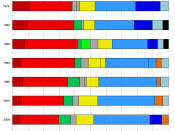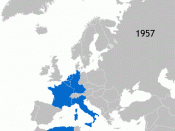The European Monetary System (EMS) was an arrangement established in 1979 where most nations of the European Economic Community (EEC) linked their currencies to prevent large fluctuations relative to one another. In 1971, most of the EEC countries agreed in 1972 to maintain stable exchange rates by preventing exchange fluctuations of more than 2.25%. In March 1979, this system was replaced by the European Monetary System (EMU). (De Grauwe, 2003)1. The development of the European Monetary UnionIn 1998 the European Exchange Rate Mechanism (ERM) was introduced as part of the EMS in order to reduce exchange rate variability and to achieve monetary stability in Europe in preparation for the European Monetary Union and for the introduction of the Euro. In 1999 ERM II replaced ERM. ERM II is an exchange rate mechanism for EU countries which are currently not taking part in the monetary union. It is up to each individual country to decide when to enter ERM II.
However, European Union member states that have not adopted the euro must participate in the ERM II for at least two years before joining the Eurozone. The participation means that the member countries aim to demonstrate the stability of their exchange rates so that their domestic currency is locked to the Euro. The purpose of this is to prepare the country for full membership of the monetary union. In the process of monetary integration of the accession countries, particular attention is devoted to ERM II, which can be described as a ÃÂwaiting roomÃÂ for the adoption of the Euro. (De Grauwe, 2003)The Maastricht Treaty developed the EMS into the European Monetary Union (EMU), which was put into operation in 1992, incorporating the introduction of a single European currency managed by the European Central Bank (ECB). On the 1st of January...


